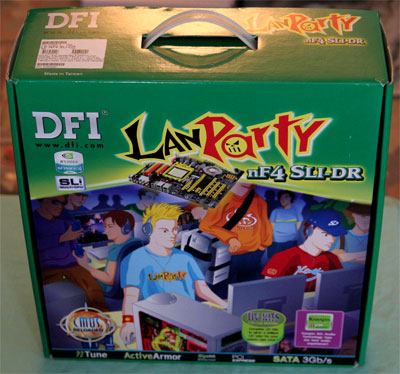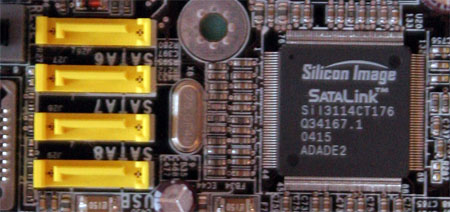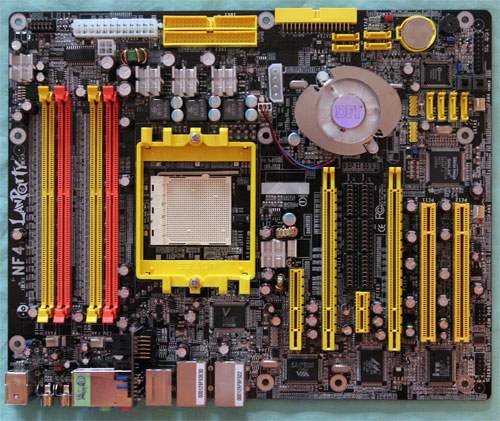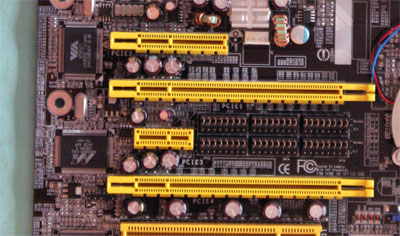nForce4 SLI Roundup: Painful and Rewarding
by Wesley Fink on February 28, 2005 7:00 AM EST- Posted in
- Motherboards
DFI LANParty nF4 SLI-DR: Features and Layout
| Specification | DFI LANParty nF4 SLI-DR |
| CPU Interface | Socket 939 Athlon 64 |
| Chipset | nForce4 SLI (single chip) |
| BUS Speeds | 200MHz to 456MHz (in 1MHz increments) |
| PCI/AGP Speeds | Asynchronous (Fixed) |
| PCI Speeds | 100MHz to 145MHz in 1MHz increments |
| Core Voltage | Auto, 0.8V to 1.55V in 0.025V increments (Normal) PLUS *104%, 110%, 113%, 123%, 126%, 133%, 136% (Special - to 1.85V) |
| CPU Startup Voltage | Startup, 0.825V to 1.550V in 0.025V increments |
| DRAM Voltage | 2.5V to 3.2V in 0.1V increments (3V jumper) 2.5V to 4.0V in 0.1V increments (5V jumper) |
| Chipset Voltage | 1.5V, 1.6V, 1.7V, 1.8V |
| Hyper Transport Ratios | Auto, 1.0, 1.5, 2.0, 2.5, 3.0, 4.0, 5.0 |
| LDT Bus Transfer | 16/16, 16/8, 8/16, 8/8 |
| LDT Voltage | 1.2V, 1.3V, 1..4V, 1.5V |
| CPU Ratios | Auto, 4x to 25x in 0.5x increments |
| Cool'n'Quiet MAX FID | Auto, 8.0 to 13.0 in 0.5x increments |
| DRAM Speeds | Auto, 100, 120, 133, 140, 150, 166, 180, 200 |
| Memory Command Rate | Auto, 1T, 2T |
| Memory Slots | Four 184-pin DDR Dual-Channel Slots Unbuffered ECC or non-ECC Memory to 4GB Total |
| Expansion Slots | 2 x16 PCIe Slots 1 x4 PCIe 1 x1 PCIe 2 PCI Slots |
| SLI Setup | Six 16-pin Jumper Blocks |
| Onboard SATA | 4-Drive SATA 2 by nF4 PLUS 4-Drive SATA by Sil3114 |
| Onboard IDE | Two Standard nVidia ATA133/100/66 (4 drives) |
| SATA/IDE RAID | 4-Drive SATA 2 PLUS 4-Drive IDE (8 total) Can be combined in RAID 0, 1 PLUS 4-Drive SATA by Sil3114 Sil3114 Raid 0, 1, 5 |
| Onboard USB 2.0/IEEE-1394 | 10 USB 2.0 ports supported nF4 2 1394A FireWire ports by VIA VT6307 |
| Onboard LAN | Dual Gigabit Ethernet PCIe by Vitesse VSC8201 PHY PCI by Marvel 88E8001 |
| Onboard Audio | Karajan Audio Module based on Realtek ALC850 8-Channel codec with 6 UAJ audio jacks, CD-in, front audio, and coaxial SPDIF In and Out |
| Other Features | Power and Reset momentary switches |
| BIOS | Award 2/17/2005 Release |
The DFI boards all support the full range of nVidia nForce4 features including nVRAID, Active Armor, SATAII 3Gb/s drives, NCQ, any-drive IDE/SATA Raid, PCIe Gigabit LAN by a PHY Ethernet chip (plus an additional PCI Gigabit LAN), and the nTune utility.
Packaging for the full LANParty nF4 SLI-DR is typical LANParty.

DFI has continued with the Karajan Audio Module first introduced on their LANParty 925x. As you will see later in our audio tests, the Karajan module was a much better performer than what we expected when we first saw the onboard Realtek 850 codec. We still wish that DFI had been able to use the High Definition ALC880 or a similar chip instead of the more common ALC850. However, the Karajan Module on the DFI SLI does provide the lowest CPU overhead that we have seen on any board using the 850.
The ALC850 Codec provides four pairs of stereo outputs, with 5-Bit volume controls and multiple stereo and mono inputs, along with flexible mixing, and gain and mute functions. Two 50mW/20ohm headset audio amplifiers are integrated at Front-Out and Surround-Out, and both amplifiers are selectable for Front-Out, Line-In and Mic-In as a Universal Audio Jack.
You can find more information on the ALC850 at Realtek.
DFI provides a full selection of rear I/O ports. These include 6 programmable audio mini jacks plus coaxial SPDIF in and out connectors to support the Realtek ALC850. The back panel also includes PS2 mouse and keyboard, 1 standard Firewire (IEEE1394a), 6 USB, and two RJ45 Gigabit Ethernet. There are no rear ports for a Parallel Printer or serial devices, but there is an onboard header for an external serial device an IR header.

The four DIMM slots support up to 4GB of up to DDR400 memory in a Dual-Channel memory configuration. Dual-Channel 1 is DIMMs 1 and 3, and Dual-Channel 2 is DIMMs 2 and 4. DFI specifies support for both ECC and non-ECC unbuffered memory. Contacts at DFI advise that best overclocking is achieved with the dual-channel DIMMs in Sockets 2 and 4.
Board Layout
The DFI LANParty nF4 SLI-DR is very well arranged, with almost everything located where it works best. As you will see if you study the layouts of the other SLI boards, the DFI differs substantially in layout.The DFI nF4 place the CPU in the top center of the board and DIMMs at the top. This arrangement worked well in our testing and should work better (for those who change memory frequently) than in the crowded right-hand alternate location used on many boards.

There is plenty of room around the Socket 939, so most Heat sink/Fans should work fine. A Zalman 7000 overhung DIMM slot 4, but it still cleared our stock OCZ memory and memory could work in all slots.
The IDE connectors are at our preferred upper right edge of the motherboard, and the floppy connector is a board edge connector located on the right edge around the middle of the board. Both locations worked well in our testing.


Asus A8N-SLI Deluxe: Overclocking and Stress Testing
DFI LANParty nF4 SLI-DR: Overclocking and Stress Testing










108 Comments
View All Comments
Heinrich - Monday, February 28, 2005 - link
Wesley did you spend any time at all on this link, I consider this to be a serious issue
http://www.rhcf.com/sisubb/ultimatebb.php/topic/21...
Heinrich - Monday, February 28, 2005 - link
When I set up my MSI board I cannot get surround sound out of the optical digital cable except for DVDs. I verified this on a few web sites. Not why there is conflicting information but mine is real world experience with current drivers (did not use packaged CDs)
giz02 - Monday, February 28, 2005 - link
#28, 31 and 32...The onboard Creative Sound Blaster Live! 24-bit samples at 192 KHz instead of 96 KHz (like Realtek's ALC880/880D and 850) and features full support for Creative's EAX HD technology. Additionally, the soundcard has also passed Dolby certification for Dolby Digital and Dolby Digital EX and has an integrated Dolby interactive content encoder!
Snip from PCStats review:
http://www.pcstats.com/articleview.cfm?articleid=1...
Dice Dice baby.. (couldn't resist)
giz02 - Monday, February 28, 2005 - link
#41 I've got a TT WS0049 PS, so I should be good with the -5v.#43 I've already cancled my DFI SLI DR board. MSI here I come ($238 cdn... so it's cheaper too) :D
Wesley Fink - Monday, February 28, 2005 - link
#42 - The on-board nF4 LAN requires a PHY (Physical Layer) gigabit LAN to function properly, but is specified as PCIe. All 4 SLI boards implement PCI Express Gigabit LAN with the PHY chips (Vitesse or Marvel). If you check all 4 manuals you will see Gigabit PCIe LAN specified by all 4 for the on-chip LAN.#40 - From the MSI manual Audio specifications:
"Dolby Digital Encoder. 24-bit/96-192kHz audio quality. Up to 100db SNR. 7.1 channel H/W audio."
ChineseDemocracyGNR - Monday, February 28, 2005 - link
Wesley,"all 4 SLI boards implement PCIe on Gigabit #1"
I don't think the onboard LAN on the nForce4 chipset uses the PCI-E bus, are you sure about this?
Spacecomber - Monday, February 28, 2005 - link
Here's the address for a MSI forum note concerning the problem with the Creative onboard sound and power supplies without a -5 volt connection.http://diamondclub.msi.com.tw/eng/forum/viewthread...
And, if you take a look at the ATX12V Power Supply Design Guide, you can see that the lack of a -5 volt connection on many current power supplies should not have come as a surprise to MSI.
http://www.formfactors.org/developer/specs/ATX12V%...
Space
giz02 - Monday, February 28, 2005 - link
WOW! This is looking good...Manual available here:
http://www.msi.com.tw/program/support/manual/mnu/s...
Page 5-1 of the MS 7100 manual (At MSI)
CA0106
Brand new Azalia Spec
8 Channel & SPDIF audio effect
Page 5-8
After installing teh creative audio driver, you are able to use teh 2-,4-,6- or 8- channel and the SPDIF audio featre now..
Page 5-11
Decoder shows SPDIF Passthrough option!!!
I am not familiar with the old Creative Live 24 hardware or menu settings, but is this new?
giz02 - Monday, February 28, 2005 - link
BTW: If this is the case, I am canceling my DFI preorder (I've been waiting almost 1 month for this board to become available....)Good things may indeed come to those who wait! There is no better way to hook up to my Z5500's if the encode is supported!
giz02 - Monday, February 28, 2005 - link
#28, #31, I'd really like to know as well...#32, I guess this is brought up, because of this statement in the roundup (on the first MSI Page)
"The Audio also fully supports Dolby Digital encoding, which will matter a great deal to some users."
Anand, is this some sort of typo, or can the onboard solution in facte ENCODE dolby digital audio. The ENCODE assumes that it can take .wav audio and encode it to dolby digital and place it on any (analog/SPDIF Coax/Toslink) output (ala IntelHD and SoundStorm)
Let us know :D